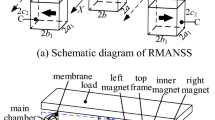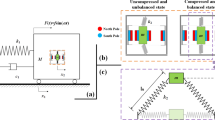Abstract
Combining magnetic negative stiffness mechanism (NSM) in parallel with positive stiffness has been considered to be an effective approach to realize the quasi-zero stiffness (QZS) characteristic, thus resolving the contradiction between high load capacity and (ultra-) low-frequency vibration isolation capability. However, the remarkable stiffness nonlinearity of common magnetic NSMs restricts the displacement region with reliable negative stiffness, resulting in considerable nonlinear behavior, poor vibration attenuation performance, and probable instability under large amplitude vibrations. A novel combined negative stiffness mechanism (CNSM) with attractive magnetic NSM (ANSM) and repulsive magnetic NSM (RNSM) in parallel is proposed in this paper. The stiffness nonlinearities of the ANSM and RNSM in the CNSM are counteracted through the parallel configuration such that the displacement region with reliable linear stiffness of the CNSM is widened by several times. An analytical model of the CNSM is established by the magnetic charge model and verified by simulation on ANSYS Maxwell. Parametric studies are then conducted to investigate the effects of design parameters on the stiffness characteristic, providing guidelines for the optimal design of the CNSM. Meanwhile, the stiffness and nonlinearity of the CNSM are compared with that of a single ANSM and RNSM. Static and dynamic experiments are finally conducted on the proposed test prototypes. Experimental results demonstrated the validity of the established model and the effectiveness of the CNSM in generating high linear stiffness within a wide displacement region and lowering the resonance frequency. Thus, the proposed CNSM can be applied in (ultra-) low-frequency vibration isolation under large amplitude excitations.
Similar content being viewed by others
References
Lu Z, Wang Z, Zhou Y, et al. Nonlinear dissipative devices in structural vibration control: A review. J Sound Vib, 2018, 423: 18–49
Ibrahim R A. Recent advances in nonlinear passive vibration isolators. J Sound Vib, 2008, 314: 371–452
Shin Y H, Kim K J. Performance enhancement of pneumatic vibration isolation tables in low frequency range by time delay control. J Sound Vib, 2009, 321: 537–553
Hartog J D. Mechanical Vibrations. New York: Dover Publications, 1985
Yao Y, Li H, Li Y, et al. Analytical and experimental investigation of a high-static-low-dynamic stiffness isolator with cam-roller-spring mechanism. Int J Mech Sci, 2020, 186: 105888
Zhang J Z, Li D, Chen M J, et al. An ultra-low frequency parallel connection nonlinear isolator for precision instruments. Key Eng Mater, 2004, 257–258: 231–238
Zhu G N, Liu J Y, Cao Q J, et al. A two degree of freedom stable quasi-zero stiffness prototype and its applications in aseismic engineering. Sci China Tech Sci, 2020, 63: 496–505
Yan B, Yu N, Wang Z, et al. Lever-type quasi-zero stiffness vibration isolator with magnetic spring. J Sound Vib, 2022, 527: 116865
Jing X, Zhang L, Feng X, et al. A novel bio-inspired anti-vibration structure for operating hand-held jackhammers. Mech Syst Signal Process, 2019, 118: 317–339
Wang Y, Jing X, Guo Y. Nonlinear analysis of a bio-inspired vertically asymmetric isolation system under different structural constraints. Nonlinear Dyn, 2019, 95: 445–464
Zhou J, Wang X, Xu D, et al. Nonlinear dynamic characteristics of a quasi-zero stiffness vibration isolator with cam-roller-spring mechanisms. J Sound Vib, 2015, 346: 53–69
Sun X, Jing X. Multi-direction vibration isolation with quasi-zero stiffness by employing geometrical nonlinearity. Mech Syst Signal Process, 2015, 62–63: 149–163
Sun X, Jing X. Analysis and design of a nonlinear stiffness and damping system with a scissor-like structure. Mech Syst Signal Process, 2016, 66–67: 723–742
Dyskin A V, Pasternak E. Mechanical effect of rotating non-spherical particles on failure in compression. Philos Mag, 2012, 92: 3451–3473
Pasternak E, Dyskin A V, Esin M. Wave propagation in materials with negative Cosserat shear modulus. Int J Eng Sci, 2016, 100: 152–161
Tan X, Wang B, Chen S, et al. A novel cylindrical negative stiffness structure for shock isolation. Composite Struct, 2019, 214: 397–405
Yuan S, Sun Y, Wang M, et al. Tunable negative stiffness spring using maxwell normal stress. Int J Mech Sci, 2021, 193: 106127
Platus D L. Negative-stiffness-mechanism vibration isolation systems. In: Proceedings of SPIE. Denver, 1991. 44–54
Le T D, Ahn K K. Experimental investigation of a vibration isolation system using negative stiffness structure. Int J Mech Sci, 2013, 70: 99–112
Carrella A, Brennan M J, Waters T P. Static analysis of a passive vibration isolator with quasi-zero-stiffness characteristic. J Sound Vib, 2007, 301: 678–689
Carrella A, Brennan M J, Kovacic I, et al. On the force transmissibility of a vibration isolator with quasi-zero-stiffness. J Sound Vib, 2009, 322: 707–717
Carrella A, Brennan M J, Waters T P, et al. Force and displacement transmissibility of a nonlinear isolator with high-static-low-dynamic-stiffness. Int J Mech Sci, 2012, 55: 22–29
Losurdo G, Bernardini M, Braccini S, et al. An inverted pendulum preisolator stage for the VIRGO suspension system. Rev Sci Instrum, 1999, 70: 2507–2515
Bazant Z P, Cedolin L. Stability of Structures: Elastic, Inelastic, Fracture, and Damage Theories. Oxford: Oxford University Press, 1991
Lakes R S. Extreme damping in compliant composites with a negative-stiffness phase. Philos Mag Lett, 2001, 81: 95–100
Estrin Y, Dyskin A V, Pasternak E, et al. Negative stiffness of a layer with topologically interlocked elements. Scripta Mater, 2003, 50: 291–294
Schaare S, Dyskin A V, Estrin Y, et al. Point loading of assemblies of interlocked cube-shaped elements. Int J Eng Sci, 2008, 46: 1228–1238
Zhou Z, Dai Z, Liu Z, et al. An adjustable low frequency vibration isolation with high-static-stiffness low-dynamic-stiffness property using a novel negative stiffness element. Appl Acoust, 2022, 188: 108571
Carrella A, Brennan M J, Waters T P, et al. On the design of a high-static-low-dynamic stiffness isolator using linear mechanical springs and magnets. J Sound Vib, 2008, 315: 712–720
Xu D, Yu Q, Zhou J, et al. Theoretical and experimental analyses of a nonlinear magnetic vibration isolator with quasi-zero-stiffness characteristic. J Sound Vib, 2013, 332: 3377–3389
Zhou N, Liu K. A tunable high-static-low-dynamic stiffness vibration isolator. J Sound Vib, 2010, 329: 1254–1273
Wu W, Chen X, Shan Y. Analysis and experiment of a vibration isolator using a novel magnetic spring with negative stiffness. J Sound Vib, 2014, 333: 2958–2970
Shan Y, Wu W, Chen X. Design of a miniaturized pneumatic vibration isolator with high-static-low-dynamic stiffness. J Vib Acoustics, 2015, 137: 045001
Zheng Y, Li Q, Yan B, et al. A Stewart isolator with high-static-low-dynamic stiffness struts based on negative stiffness magnetic springs. J Sound Vib, 2018, 422: 390–408
Wang Q, Zhou J, Xu D, et al. Design and experimental investigation of ultra-low frequency vibration isolation during neonatal transport. Mech Syst Signal Process, 2020, 139: 106633
Pu H, Yuan S, Peng Y, et al. Multi-layer electromagnetic spring with tunable negative stiffness for semi-active vibration isolation. Mech Syst Signal Process, 2019, 121: 942–960
Yan B, Ma H, Jian B, et al. Nonlinear dynamics analysis of a bi-state nonlinear vibration isolator with symmetric permanent magnets. Nonlinear Dyn, 2019, 97: 2499–2519
Wu J, Zeng L, Han B, et al. Analysis and design of a novel arrayed magnetic spring with high negative stiffness for low-frequency vibration isolation. Int J Mech Sci, 2022, 216: 106980
Allag H, Yonnet J P. 3-D analytical calculation of the torque and force exerted between two cuboidal magnets. IEEE Trans Magn, 2009, 45: 3969–3972
Author information
Authors and Affiliations
Corresponding author
Additional information
This work was supported by the National Natural Science Foundation of China (Grant No. 52075193), the National Key R&D Program of China (Grant Nos. 2020YFB2007301 and 2020YFB2007601), China Postdoctoral Science Foundation (Grant No. 2022M711250), and the National Science and Technology Major Project of China (Grant No. 2017ZX02101007-002).
Rights and permissions
About this article
Cite this article
Wu, J., Che, J., Chen, X. et al. Design of a combined magnetic negative stiffness mechanism with high linearity in a wide working region. Sci. China Technol. Sci. 65, 2127–2142 (2022). https://doi.org/10.1007/s11431-022-2121-7
Received:
Accepted:
Published:
Issue Date:
DOI: https://doi.org/10.1007/s11431-022-2121-7




